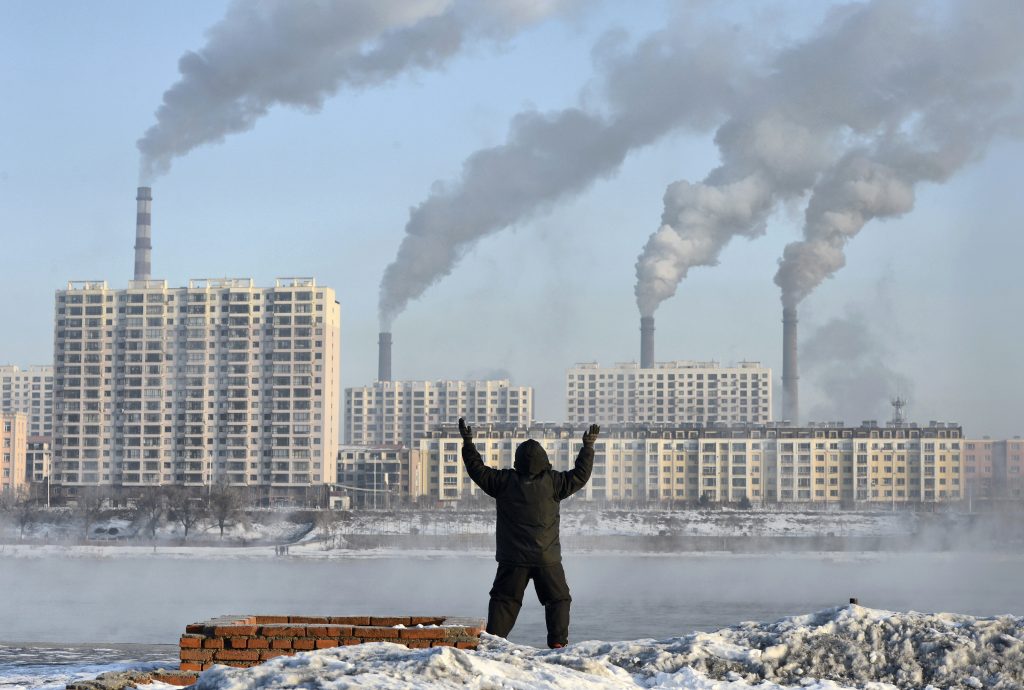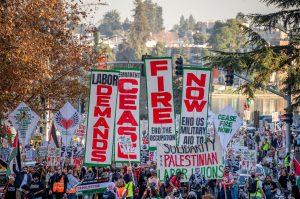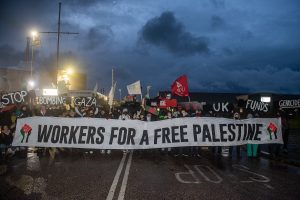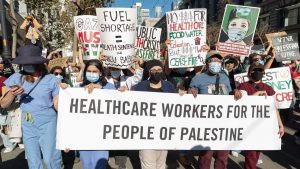On the eve of the 2021 United Nations Climate Change Conference (COP26) that opened in Glasgow on Sunday, October 31, two presidents — Joe Biden and Ursula von der Leyen of the European Union (EU) — struck a deal being touted as a “green steel pact.” It reverses the 25 percent tariff Donald Trump had imposed on EU steel imports, which had provoked retaliatory tariffs, but uses the same approach by both parties against other countries “that fail to hit standards for low-carbon steel production” — countries that just happen to be consistently eclipsing Europe and the United States when it comes to market share.
It’s certainly not a new idea to use tariffs on trade as a way to cut carbon emissions. Nobel laureate economist Joseph Stiglitz famously raised the idea in 2006 at a meeting of the Center for Global Development, where he argued that “if you can impose a trade sanction to save a turtle, you can impose a trade sanction to save the planet.” But as the Wall Street Journal — the mouthpiece of an important sector of the U.S. ruling class — makes clear, even if not deliberately, such moves cannot be seen as exclusively about addressing climate change, if genuinely about that at all. “The idea has the potential to rewrite the rules of global commerce,” the Journal notes, and serve so many more of capitalism’s interests.
The plan, the Journal continues, “came as part of an effort to curb global overcapacity for steel and aluminum, which U.S. officials have attributed largely to China.” What does that have to do with emissions, specifically? Nothing. But it has everything to do with profits, competition, and imperialism. According to the Organisation for Economic Co-operation and Development (OECD), global excess capacity in steel is 5.8 times the productive capacity of the entire U.S. steel industry. That means firms are producing at a lower scale of output than factories have been designed for, and when there’s too much excess capacity, companies have trouble selling their products for an amount at or above production costs.
Losing money is not in the interest of U.S. steelmakers, and excess capacity has other implications as well. The Economic Policy Institute states, “Massive overcapacity driven by subsidies and other anti-competitive policies can only be disposed of by these producers flooding U.S. and other markets with exports, posing material harm to U.S. steel producers and risking the U.S. industry’s ability to maintain operations, grow, and invest in areas essential to national defense, critical infrastructure, and broader economic welfare.”
No mention of the environment, emissions, or climate change. So, what’s behind all this tariff talk?
In a 1929 article, Leon Trotsky wrote, “Tariff barriers are erected precisely because they are profitable and indispensable to one national bourgeoisie to the detriment of another.” It’s a critically important point to keep in mind whenever the capitalists raise the specter of tariffs for some other reason — especially as a mechanism for achieving some sort of “social good,.” like curbing emissions.
What Are Tariffs?
Tariffs are a tax a country imposes on imports, and are designed to make foreign-made goods more expensive. The aim is to help domestic producers of the same goods or, in some cases, force exporters in other countries to cut their prices as a way to stay competitive. But as every honest economist, bourgeois or otherwise, will tell you, tariffs function, in essence, as taxes on consumers. They result in higher prices for people in the country imposing the tariff, because it’s the importer, not the exporter, that pays the tariff.
Tariff bills are due when goods arrive at the port of entry, and the money goes to the government. How do importers cover those bills? They pass on their additional costs to the buyers of the good, whether that is an end consumer directly or another company that uses the good in its production process — and that eventually passes on the cost to end consumers. That fact is more proof that the entire tariff story at COP26 is really about safeguarding profits; if the costs aren’t passed on to consumers, it’s the producers themselves that have to bear that burden.
In fact, some 82 years before Trotsky, Karl Marx had expressed the same idea. He noted,
The system of protective tariffs places in the hands of the capital of one country the weapons which enable it to defy the capital of other countries; it increases the strength of this capital in opposition to foreign capital, and at the same time it deludes itself that the very same means will make that same capital small and weak in opposition to the working class. In the last analysis that would mean appealing to the philanthropy of capital, as though capital as such could be a philanthropist.
During his presidency, as he waged a trade war with China, Donald Trump repeatedly claimed that China was footing the bill for the huge tariffs he had imposed on that country. The idea that his actions were “taxing the hell out of China” was one of his many bald-faced lies. In fact, as a report from the National Bureau of Economic Research makes clear, Trump’s 2018 actions created “substantial increases in the prices of intermediates and final goods … and complete passthrough of the tariffs into domestic prices of imported goods.” In other words, we paid higher prices.
“Overall … the full incidence of the tariff falls on domestic consumers, with a reduction in U.S. real income of $1.4 billion per month by the end of 2018.” That’s a lot of money.
In 2018, lots of corporate executives spoke out publicly against Trump’s tariffs, citing the potential for higher prices and job losses. So why would they embrace the idea now?
Competition with China: The Example of Steel
The competition between U.S. imperialism and China is being referred to by a growing number of analysts as a new “Cold War” — one with broad geopolitical implications that, of course, have economics at their root. As the “world’s factory,” China has cut into the competitiveness of U.S. capitalism significantly in a broad range of sectors, steel being one of the most important. In 2020, China accounted for 57 percent of global steel production, and about 10 times more than the United States — which ranks fourth in the world, eclipsed by Japan and notably, India (a developing country).
It’s a remarkable reversal. At the end of World War II, the U.S. steel industry was the strongest one in this country and ruled the world, where demand for steel was voracious as Europe and Asia both rebuilt and American cities expanded. U.S. steel mills employed an average of 700,000 workers between 1948 and 1958. Today, that number is well less than 100,000. Part of that decline can be attributed to production efficiencies realized in U.S. mills with new technologies, but that’s not the entire technology story. Foreign competitors in Europe and Japan adopted new technologies much more quickly than the American capitalists, who liked the surplus value they extracted from workers without making new investments. That gave competitors an advantage.
And then along came China. The country’s industrialization “led to a boom in the steel industry there unlike anything since the industrial revolution.” By 1993, Chinese steel output matched U.S. production, and has since increased by more than 800 percent. All that drove down what U.S. companies could charge for their steel — and the capitalists have been looking for ways to compete, directly or indirectly (which is where tariffs come in), ever since.
It’s not just about steel, though. The rise of China has had a profound impact on U.S. capitalism in other ways as well. Much of that impact flows from economic changes in the United States that predate the rapid industrialization of China that began in the latter part of the 20th century.
The tremendous boom in production in the United States that began in the 1930s, accelerated with the manufacturing of the machinery of destruction for World War II, and continued after the war, was fueled by massive investments in new productive machinery, new roads and so on — often with significant taxpayer money involved. But the past few decades have seen a decline in average profit rates and productivity growth, a financialization of the U.S. economy that has the capitalists looking to the markets rather than production as the way to make money, outsourcing of industry, and so on. U.S. economic growth slowed — now it’s only about 2 percent per year — while China’s economy exploded. What’s a national bourgeoisie to do? It’s everything Trotsky and Marx wrote about tariffs — and more. The capitalists have an imperative to protect their system when its position in the world is threatened.
These deeper economic forces aren’t going away. The rivalry — between imperialisms, between capitalist states, between China and the United States most pronouncedly — will persist because of the inner dynamics of capitalism itself.
Expanding the Tariffs to Other Industries
That reality for capitalism is why proposals making their way around the COP26 meetings include tariffs on cement and chemicals, too. Here we see the same pattern as with steel. China produces the most cement of any country in the world, by a very large margin: some 2.2 billion metric tons last year, followed by India at 340 million, Vietnam at 96 million, and the United States — ranked fourth — at 90 million. This gives China a tremendous competitive edge globally, especially in terms of providing cement to the developing world, which is yet another way in which China can expand its influence in Africa, Latin America, the rest of Asia, and elsewhere.
The cement industry is a massive polluter, and has a huge impact on China’s ranking as an emitter of CO2. A 2018 analysis noted that if the cement industry were a country, it would be the third-largest source of CO2 emissions in the world, behind China and the United States.
But again, don’t be fooled. None of the imperialist countries have come close to meeting targets they’ve agreed to for reducing emissions, even the modest ones from the Paris Agreement. Concern with China’s climate-change effects, and targeting the cement industry, are really about capitalist competition around the globe and seeking to slow down China’s own internal growth, which paints a damning picture of U.S. capitalism’s particular unwillingness to invest in the United States. After all, as the Guardian reported in 2019, “Since 2003, China has poured more cement every two years than the US managed in the entire 20th century.” Even beyond what it exports, the country itself “uses almost half the world’s concrete. The construction sector — roads, bridges, railways, urban development and other concrete-and-steel projects — accounted for one-third of the expansion of the Chinese economy in 2017.”
When it comes to China, the figures for chemicals are similar. Chemicals are a crucial component of the supply chain network; their production converts raw materials such as water, minerals, metals, fossil fuels, and others into tens of thousands of products, many of which are used every day across the globe. China enjoys a 40.6 percent share of global chemical industry revenue, far surpassing the European Union (14.8 percent) and the United States (13.8) percent.
Serving Capitalism’s Interests
It is absolutely true that U.S. steel production emits far less carbon than production in countries that still rely on high-polluting blast furnaces. For decades, U.S. steelmakers have invested in more efficient production methods — for instance, methods that recycle scrap metal — and other technology improvements that have reduced their carbon footprints. But this has been driven not by any sort of “tree-hugger” environmental awareness, but in response to environmental regulations imposed on the industry despite massive lobbying to keep it from happening, and from a desire to reduce the need for pesky human labor from workers who always seem to want higher wages and better benefits.
Any environmental benefit, therefore, has to be seen as a useful byproduct of imposing tariffs — and useful mostly in terms of public relations. Giant polluting corporations love to be able to present themselves as environmentally friendly; it’s part and parcel of their global greenwashing efforts — which, like the idea of a carbon tariff itself, isn’t new. These efforts run the gamut from misleading packaging to polluters advertising their eco-friendliness to efforts to justify shifting jobs to unregulated, low-wage countries as part of saving the world, as the oil and gas giant Total has been claiming in France.
ExxonMobil spends millions of dollars to advertise that its experimental algae biofuels could lead to huge reductions in transport-related emissions, while touting its own emission reduction targets that exclude most of what its products emit. Volkswagen, BMW, Chevrolet, and Ford have all been caught having installed emissions-cheating software into their vehicles so they can deceptively claim they are “clean” and environmentally friendly.
“Fast fashion” brands such as Uniqlo advertise their green initiatives and help fund environmental NGOs while contributing to massive amounts of textile waste, some 80 percent of which globally is incinerated or dumped in landfills. H&M, another “fast fashion” brand, introduced its “Conscious” line of “green” clothing with absolutely no discernible environmental benefits. The list goes on and on.
Just like every other greenwashing example, the ability to continue reaping profits while appearing to be responsive to calls for environmental consciousness is at the root. These proposed tariffs have the potential to raise revenues for capitalist governments, protect domestic producers in the sectors being proposed, and exert political leverage over other countries. They are, to quote Trotsky again, “profitable and indispensable to one national bourgeoisie to the detriment of another.”
“It will be hard to avoid accusations of green protectionism, given how the starting point clearly is concern about low-cost foreign production.” That’s how Michael Mehling, deputy director of the Center for Energy and Environmental Policy Research at the Massachusetts Institute of Technology, characterized the deal struck between Biden and von der Leyen.
So, considering capitalism’s history of addressing climate change, when the Wall Street Journal describes “using tariffs on trade to cut carbon emissions” but also notes that the tariffs “would give a competitive advantage to manufacturers in countries where emissions are relatively low,” which of those do you think is the real objective?
Every aspect of capitalism as a system stands in sharp contrast to the very idea of a sustainable planet, let alone of saving something that the system has already so profoundly destroyed in the interest of profit. The exploitation of nature for the purpose of amassing wealth in the hands of the few is as fundamental to capitalism as is the exploitation of human labor. Tariffs won’t save the planet. Only overthrowing capitalism, and soon, has a chance.











